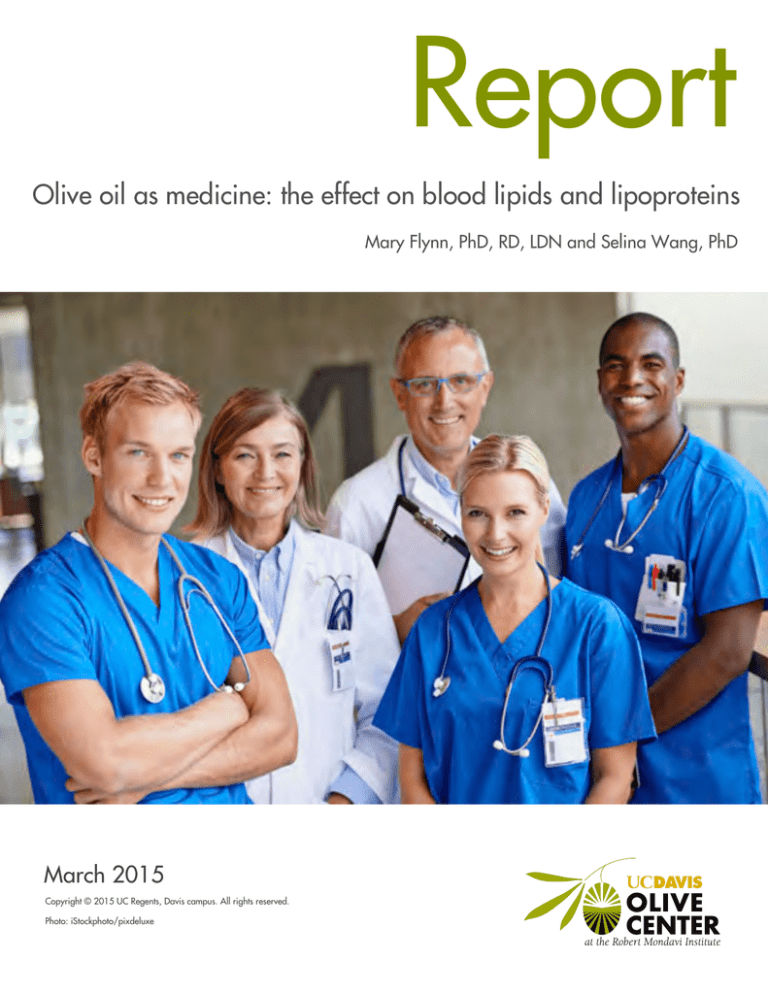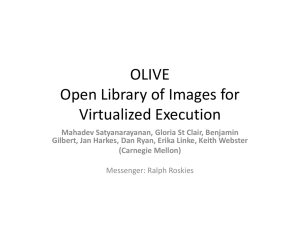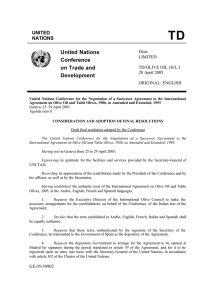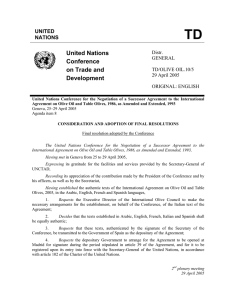
Report
Olive oil as medicine: the effect on blood lipids and lipoproteins
Mary Flynn, PhD, RD, LDN and Selina Wang, PhD
March 2015
Copyright © 2015 UC Regents, Davis campus. All rights reserved.
Photo: iStockphoto/pixdeluxe
Olive oil as medicine: the effect on lipids and lipoproteins
This report focuses on studies examining the effect of olive oil on blood lipids (cholesterol and triglycerides) and
lipoproteins (LDL, VLDL, and HDL). It is the first in a series of reports that summarize published studies examining the
effect of extra virgin olive oil (EVOO) on clinical risk factors for chronic diseases. These reports provide clinicians with
science-based information and practical advice on how to teach patients to incorporate EVOO into the diet.
Summary
• Two tablespoons of extra virgin olive oil (EVOO) a day may decrease the risk of heart disease by improving blood
levels of lipids and lipoproteins.
• EVOO with a higher phenol content can provide more health benefits than EVOO with a lower phenol content.
• Strategies for obtaining a quality EVOO include selecting oils with a harvest date from the most recent season as well
as choosing containers that protect the oil from light.
Background
Lipids and lipoproteins. The blood lipids are cholesterol and triglyceride, which are carried in the blood by
lipoproteins. Lipoproteins are lipids combined with specific proteins, known as apoproteins, which make the lipoprotein
particle soluble in blood. The major lipoproteins are: very low-density lipoprotein cholesterol (VLDL), which is made by
the liver to carry primarily endogenous triglyceride; low-density lipoprotein cholesterol (LDL), which is made from VLDL
when sufficient triglyceride has been removed; and high-density lipoprotein cholesterol (HDL). Clinical laboratory
values provide an analysis for total cholesterol (TC), HDL, and triglycerides. LDL is calculated from these values. The
relationship of these values is:
TC = LDL + HDL + triglycerides/5 [which provides an estimate of VLDL]
Olive oil is a key component of the Mediterranean Diet. The health benefits of olive oil have been recognized
since the 1970s with the publication of the Seven Countries Study of international heart disease rates (1). The results
showed that men on the island of Crete consumed more total fat than American men, yet had heart disease rates that
were more than 80 percent lower. The main source of dietary fat for the Greek men was extra virgin olive oil and the
diet was mainly plant-based whereas the main sources of dietary fat for American men were from animal products.
The study found that plant-based meals that included substantial consumption of fruit, vegetables, legumes, unrefined
cereals, and olive oil were prevalent in areas bordering the Mediterranean Sea, which led the study to call this way of
eating the “Mediterranean Diet.” The Mediterranean Diet has since been associated with better health and lower rates
of chronic diseases, including cardiovascular disease and some cancers, in a number of observational and
interventional studies. Extra virgin olive oil (EVOO) is the only food source rich in monounsaturated fat that has been
shown to have health benefits and is a fundamental component of the health benefits of the traditional Mediterranean
Diet.
Phenols are essential to EVOO’s health benefits. Due to minimal processing, EVOO is the only oil that retains
important natural phenols. EVOO is processed in a manner similar to many fruit juices: the fruit is crushed and the
juice is extracted. In contrast, the other grades of olive oil (“pure” and “light”), as well as inexpensive oils such as
soybean and canola, go through an industrial refining process that strips away phenols. Phenolics (sometime called
phenols) are a general class of chemical compounds consisting of simple phenols and polyphenols. Molecules with
multiple phenol units are known as polyphenols, although the terms “phenols” and “polyphenols” often are used
interchangeably. EVOO consists of at least 30 phenolics (2), which includes the simple phenolics, tyrosol and
1
hydroxytyrosol; the secoiridoids, oleouropien and oleocanthal; and lignans (3, 4). The total phenol content is typically
expressed as mg/kg of olive oil. Besides genetics (5), other factors such as soil, irrigation, climate, and degree of
ripeness and processing methods can have significant impact on the total polyphenol content of an olive oil (6). Large
variations in EVOO phenol content may explain why quality standards do not require a minimum phenol content to
qualify an olive oil as “extra virgin,” nor do standards classify EVOO as low, medium, or high in total phenols (7).
EVOO with a higher phenolic content may have a more robust flavor, including some bitterness, than EVOO with lower
phenolic content, and phenolic content diminishes with time.
EVOO quality is highly variable. Olive oil adulteration is an international concern and may be widespread (8),
moreover, oils sold as EVOO often do not meet the minimal quality standards for the grade. For example, a 2010
study by the UC Davis Olive Center found that two-thirds of imported commodity olive oils labeled as “extra virgin”
failed federal grade standards (often the oils were stale or rancid-tasting.) The UC Davis study also found that
adulteration tests were inconclusive, and that the tests could not rule out whether the oils were adulterated with refined
olive oil. The UC Davis study found that total phenols in the oils that were analyzed had a wide range, from 80 to 450
mg/kg, but containers generally do not indicate the phenolic content of the oils. Some strategies for obtaining a quality
EVOO include selecting oils from the most recent harvest (generally October through December for the Northern
Hemisphere, April through June for the Southern Hemisphere), and choosing containers that protect the oil from light.
While many EVOO containers do not include a harvest date, better-quality oils often will have the date on the
container. The harvest date differs from a “best-before” date. Typically the bottler establishes a “best-before” date that
is 18 months to 24 months from the date when the container is filled, not when the oil is processed.
Methodology
PubMed was searched for human studies written in English published from January 1998 through December 2014. All
computer searches used the word “olive oil” combined with the risk factor key words of: blood lipids; triglycerides;
VLDL; HDL; LDL; lipoproteins; and LDL oxidation. Inclusion criteria were: human studies; randomized, controlled clinical
intervention trials testing the effect of olive oil on at least one of the listed clinical risk factors. Studies were included that
listed “olive oil” without further description. Exclusion criteria were: lack of randomization; lack of control group;
animal or in vitro studies; use of other oils or foods in combination with olive oil; lack of information on amount of olive
oil tested; studies that only used one meal with olive oil; stated use of pomace oil, only refined olive oil, olive oil
extracts, or only olive oil components (e.g., phenols). Observational studies and review articles were also excluded.
Findings
EVOO may reduce LDL. Daily use of at least 1.5 tablespoons (20 grams) of EVOO for a minimum of six weeks
could decrease LDL 10 percent or greater from baseline. Consuming more EVOO per day and/or consuming an
EVOO with a higher total phenol content (> 300 mg/kg) could lead to similar or greater LDL reductions in a shorter
time period.
Discussion
LDL has been the lipoprotein most researched since the 1980s, primarily because LDL
is the lipoprotein with the highest cholesterol content. For this reason, when TC is
elevated, LDL is also frequently elevated. The majority of the dietary studies have
focused on the effect of saturated fat on LDL levels. Relatively few studies have
assessed the effect of EVOO on LDL levels, but the studies summarized below indicate
that EVOO may improve blood levels of LDL.
Tablespoon = 13.5 grams or 12.5 ml
Teaspoon = 4.5 grams or 4.2 ml
Three studies included men and women, all older than 50 years of age, with elevated
LDL (mean: > 185 mg/dl). In one of the studies (n=28 participants; mean age: 68 years), consumption of 20 grams a
day of EVOO for six weeks resulted in an LDL decrease of 30 mg/dl, or a 15 percent decrease from baseline values
2
Olive oil as medicine: the effect on lipids and lipoproteins
UC Davis Olive Center at the Robert Mondavi Institute
(9). A study of 18 men and women (mean age: 56 years) found that four weeks of 35 to 50 grams a day of EVOO
(amount consumed was relative to total energy consumed by the participant) led to an 8 percent decrease in LDL for the
group (baseline LDL: 196 mg/dl) (10). The third study used 50 ml a day of EVOO for six weeks and provided changes
by gender (11). LDL reductions were greater in men (11 percent) than women (7 percent), despite higher baseline LDL
in the women (men: 123.1 ± 11.5 mg/dl. v women: 131.3 ± 12.8 mg/dl).
USDA standard
Two studies indicate that EVOO with higher phenol content may improve LDL levels. Casteñer et al., (12) compared an
olive oil with a total phenol content of 2.7 mg/kg (refined olive oil) to an EVOO of 366 mg/kg in men (mean age of
participants: 38.2 ± 11.5 years) with daily consumption of 25 ml for three weeks of each oil. The study found that the
oil containing 366 mg/kg decreased LDL 6.3 ± 4.8 mg/dl, while the 2.7 mg/kg oil increased LDL 6.4 ± 4.8 (p =
0.028). In another study, Marrugat et al., gave three oils with differing phenol contents (undetectable, 68 mg/kg, and
150 mg/kg total phenol content) to 30 Spanish men, who consumed 25 ml of each oil for three weeks (13). While the
three oils made no difference in the LDL levels of the men, the EVOO with the phenol content of 150 mg/dl was the only
oil to decrease LDL oxidation.
Studies comparing EVOO to vegetable oils for their effect on LDL levels show conflicting results. Madigan, et al. (14)
compared EVOO and sunflower oil (SO) for two weeks at 30 ml a day in 11 men with type 2 diabetes and reported
that both TC (SO: 204.9 ± 23.2 vs EVOO: 189.5 ± 19.3 mg/dl; p < 0.001) and LDL (SO: 123.7 ± 19.3 vs EVOO:
116.0 ± 19.3 mg/dl; p < 0.001) were significantly higher on the SO compared to values after EVOO. Pedersen, et al.
(15) compared three weeks each of 50 grams a day of EVOO, canola oil, and SO. LDL levels were significantly lower
after the canola oil and SO diets compared to the values after EVOO.
EVOO reduces oxidation of LDL. EVOO consumption will clearly decrease LDL oxidation while oils high in
polyunsaturated fat (all vegetable seed oils and fish oils) will increase LDL oxidation. Consuming two tablespoons (25
ml) a day of an EVOO containing a high total phenolic content (> 400 mg/kg) may reduce LDL oxidation in as little as
four days. Two tablespoons a day of EVOO with a total phenolic content at least 150 mg/kg may decrease LDL
oxidation in less than four weeks.
Discussion
Phenol content explains the ability of EVOO to decrease lipid oxidation. A study from EUROLIVE (Effect of Olive Oil
Consumption on Oxidative Damage in European Populations) showed that three weeks of consuming 50 ml a day of
EVOO with 161 mg/kg total phenols decreased LDL oxidation compared to olive oil with 14.7 mg/kg total phenols in
40 men with stable heart disease (21). Another study that compared 25 ml of olive oil with varying phenolic content
levels ranging from undetectable to 68 mg/kg to 150 mg/kg in 30 healthy men showed a decrease in LDL oxidation
only for the olive oil with the 150 mg/kg content (13).
Specific phenols may differ in their ability to decrease LDL oxidation, as not all studies indicate a benefit with similar
total phenol content. A EUROLIVE study comparing olive oils with different phenolic content levels (2.7 mg/kg, 164
mg/kg, and 336 mg/kg) at 25 ml a day for three weeks of each oil showed a linear decrease in LDL oxidation with
increasing phenol content, but the results were statistically significant only for the olive oil with 336 mg/kg (22).
Another study comparing olive oils that would qualify as refined olive oil to olive oil with high total phenol content (366
mg/kg) for three weeks at 25 ml/day (12) or 564 mg/kg for eight weeks at 30 mg/day (23), showed a significant
decrease in LDL oxidation after consumption of the higher-phenol-content EVOO compared to the olive oil with the
lower-phenol-content.
EVOO with high phenol content also may decrease LDL oxidation quickly. In a study on the island of Crete, 12 young
(mean age: 21 years) men who consumed 25 ml a day for only four days of olive oils with varying levels of total
phenols found that the olive oil with a phenol content of 486 mg/kg could decrease LDL oxidation. (24).
3
Olive oil as medicine: the effect on lipids and lipoproteins
UC Davis Olive Center at the Robert Mondavi Institute
EVOO could improve VLDL (fasting triglycerides.) The blood level of VLDL is mainly related to the amount of
carbohydrate in the diet, with higher carbohydrate diets (≥ 55% of total energy intake) increasing VLDL. There are not
published studies that assess the effect of EVOO compared to other oils on fasting triglycerides; however, the inclusion
of EVOO in a meal would lead to healthier fasting triglycerides and postprandial (i.e., after a meal) triglycerides, given
that EVOO would not contribute to oxidation.
EVOO may increase HDL. Olive oil is the only food known to independently increase HDL. Consumption of
EVOO at a minimum of two tablespoons (25 ml) a day may increase HDL in as little as four days. EVOO with higher
total phenols should result in greater HDL increases, with increases in HDL2 and improvement in HDL function. The
changes in HDL may depend on the initial values, but a linear increase in HDL could be expected relative to total phenol
content.
Discussion
HDL levels have been inversely related to risk of coronary heart disease. The blood level of HDL is primarily determined
by genetics. However, diet will influence HDL levels and HDL is typically more diet-sensitive than LDL. HDL levels are
inversely related to fasting triglycerides. Diets that are lower in fat (likely ≤ 25% fat) and higher in carbohydrate (≥
55% carbohydrate) will result in an increase in fasting triglycerides and a decrease in HDL (25) compared to diets
higher in total fat. While the literature predominantly shows that consuming any dietary fat, excepting trans fat, will
increase HDL compared to a lower-fat diet, the inclusion of olive oil seems to lead to an independent increase in HDL.
A study of 62 elderly men and women (65 to 96 years old) who consumed 50 ml a day of EVOO for six weeks led to
an increased HDL in both the men (baseline: 56.5 ± 7.1 mg/dl vs 62.9 ± 3.2 mg/dl after EVOO) and the women
(baseline: 53.2 mg/dl vs 59.8 mg/dl after EVOO), compared to a control group that did not consume EVOO (11).
Several studies examining the effect of olive oil on HDL levels have compared oils by total phenol content. Three studies
compared olive oil with less than 10 mg/kg total phenols (refined olive oil) to two olive oils with higher total phenol
content (13, 22, 24). In a study of 30 healthy men from a Spanish religious center, three weeks of 25 ml a day of
EVOO with 150 mg/kg total phenols increased HDL from a baseline of 60.6 ± 11.2 mg/dl to 63.7 ± 12.3 mg/dl,
compared to no change in HDL for olive oil with either 68 mg/kg or olive oil with undetectable phenols (13). A
EUROLIVE study compared 25 ml a day of olive oil for three weeks each using oils with 2.7 mg/kg, 164 mg/kg, and
366 mg/kg of total phenols and found a linear increase in HDL relative to phenol content (22). In young men (20 to 22
years old), 25 ml of EVOO a day with both 133 mg/kg and 486 mg/kg increased HDL in only 4 days, also with a
linear increase relative to the phenol content (24).
Not all studies show olive oil will increase HDL levels. Madigan, et al. (14) showed reductions in TC and LDL after two
weeks of 30 ml EVOO compared to sunflower oil, found no difference in HDL levels. In a controlled diet study of 18
young men (mean age: 24 years old), 50 grams a day of EVOO resulted in HDL levels that tended to be higher but was
not significantly different from 50 grams a day of canola or sunflower oil (15). In 18 men in a EUROLIVE study that
was conducted primarily to examine changes in the expressions of genes involved in LDL oxidation, three weeks of 25
ml a day of EVOO with a total phenol content of 366 mg/kg did not increase HDL compared to olive oil with 2.7 mg/
kg total phenols (12); however, these men started with a mean HDL of 47 mg/dl, which is a relatively high value for
men. Another EUROLIVE study of 47 men who also consumed 25 ml a day of olive oil with 2.7 and 366 mg/kg total
phenols for three weeks each found that the extra virgin olive oil with the higher total phenols did not change total HDL
but it did change the HDL composition such that there was a significant increase in HDL2 (26), which is thought to be
the cardio-protective fraction of HDL. In addition, there was a significant improvement in both the cholesterol efflux
capacity and oxidative state of the HDL, indicating a significant improvement in HDL function after consuming EVOO
with a total phenol content of 366 mg/kg.
4
Olive oil as medicine: the effect on lipids and lipoproteins
UC Davis Olive Center at the Robert Mondavi Institute
Conclusions
Daily use of at least two tablespoons of EVOO can improve the lipid profile with decreases in LDL and increases in HDL;
higher daily intakes may produce greater improvements. The use of EVOO with a total phenol content of at least 300
mg/dl may decrease LDL, while the increase in HDL could be seen with EVOO with lower total phenols, starting around
150 mg/kg; larger increases in HDL would be expected with higher total phenol content. Higher phenol content EVOO
(>300 mg/kg) should also improve the HDL particle by increasing the HDL2 content and the function of HDL with
improvement in cholesterol efflux. In addition, the use of EVOO will improve fasting and postprandial lipids by
decreasing lipid oxidation and providing phenols that work as general antioxidants.
The health benefits of EVOO are strongly related to phenol content, with the monounsaturated fat content providing a
much less significant role. For this reason, those wanting to maximize potential health benefits from EVOO should seek
EVOO with higher phenol content, which is generally indicated by EVOO with a robust flavor that may include some
bitterness. EVOO is the only oil that is high both in monounsaturated fat and phenol content, and comparable health
benefits would not be provided by other oils or foods.
Unfortunately, EVOO labels often do not usually reveal phenolic content, phenols diminish with time, and studies have
shown that a high percentage of oils sold as EVOO was not fresh. Some strategies for improving one’s chances of
obtaining a quality EVOO include selecting oils with a harvest date from the most recent season as well as choosing
containers that protect the oil from light.
Future research should further test the effect of higher phenol content olive oil to improve the lipid profile. Establishing
the minimum phenol content needed to achieve a healthy lipid profile would be useful, as would research to determine
if specific phenols provide more benefit than others. Studies that test the health effects of EVOO should include the
source of the oil, the phenol content, and the varietal. These factors will all help the consumer choose an olive oil that
would best improve their lipid profile. Such research could start with small trials in multiple clinical centers using EVOO
from a reputable source and with a known phenol content.
Authors
Mary M. Flynn, PhD, RD, LDN is an Associate Professor of Medicine (Clinical) at Brown University.
She teaches courses in nutrition at Brown, and lectures on nutrition in the Brown Medical School.
She has been a research dietitian since 1984 at The Miriam Hospital in Providence, Rhode Island.
Her main research interest is how food can be used as medicine and her main food of interest is
extra virgin olive oil. In 2013, she founded The Olive Oil Health Initiative of The Miriam Hospital
at Brown University, which has the mission of educating the public and medical community on the
health benefits of olive oil. She has developed a plant-based, olive oil diet that she has tested for
weight loss in women diagnosed with invasive breast cancer; weight loss and improvement in
components of the metabolic syndrome in men with prostate cancer; and reducing food insecurity in food-pantry clients.
She is co-author of the books Low-Fat Lies, High-Fat Frauds, and the Healthiest Diet in the World (Lifeline Press, 1999)
and The Pink Ribbon Diet (Da Capo Press, October 2010) which is a weight-loss program and
cookbook based on her plant based, olive oil diet for women who have had breast cancer.
Selina Wang, PhD, has served as research director of the UC Davis Olive Center since 2012,
where she has developed more than 50 projects, launched a research laboratory and mentored
dozens of students. She is interested in developing practical solutions and in pushing innovation,
particularly in developing improved scientific methods for assessing quality and authenticity. She
5
Olive oil as medicine: the effect on lipids and lipoproteins
UC Davis Olive Center at the Robert Mondavi Institute
was a scientific advisor to a project that developed a rapid biosensor of olive oil rancidity, winning the 2014 grand
prize in the world’s most important student biotechnology competition. Dr. Wang received a B.S. in Chemistry from the
University of California, Santa Cruz and a Ph.D. in Chemistry from the University of California, Davis.
References
1.
Keys A. Coronary heart disease in seven countries. Circulation 1970;40:1-211.
2.
Tuck KL, Hayball PJ. Major phenolic compounds in olive oil: metabolism and health effects. J Nutr Biochem 2002;13:636-644.
3.
Corona G, Spencer JP, Dessi MA. Extra virgin olive oil phenolics: absorption, metabolism, and biological activities in the GI tract. Toxicol Ind
Health 2009;25:285-93.
4.
Karkoula E, Skantzari A, Melliou E, Magiatis P. Direct measurement of oleocanthal and oleacein levels in olive oil by quantitative (1)H NMR.
Establishment of a new index for the characterization of extra virgin olive oils. J Agric Food Chem 2012;60:11696-703.
5.
Haddada F KD, Manai H, Oueslati I, Daoud D, Zarrouk M. Analytical evaluation of six monovarietal virgin olive oils from Northern Tunisia. Eur
Lipid Sci Tech 2008;110:905-913.
6.
Baiano A TC, Viggiani I, Nobile MAD. Effects of cultivars and location on quality, phenolic content and antioxidant activity of extra-virgin olive
oils. J Am Oil Chem Soc 2013;90:103-111.
7.
Gawel R RD. The relationship between total phenol concentration and the perceived style of extra virgin olive oil. GRASAS Y ACEITES
2009;60:134-138.
8.
Mueller T. Extra Virginity. The sublime and scandalous world of olive oil. New York: W.W. Norton, 2012.
9.
Haban P, Klvanova J, Zidekova E, Nagyova A. Dietary supplementation with olive oil leads to improved lipoprotein spectrum and lower n-6
PUFAs in elderly subjects. Med Sci Monit 2004;10:PI49-54.
10. Damasceno NR, Pérez-Heras A, Serra M, et al. Crossover study of diets enriched with virgin olive oil, walnuts or almonds. Effects on lipids and
other cardiovascular risk markers. Nutr Metab Cardiovasc Dis 2011;21 Suppl 1:S14-20.
11. Oliveras-López MJ, Molina JJ, Mir MV, Rey EF, Martin F, de la Serrana HL. Extra virgin olive oil (EVOO) consumption and antioxidant status in
healthy institutionalized elderly humans. Arch Gerontol Geriatr 2013;57:234-42.
12. Castañer O, Covas MI, Khymenets O, et al. Protection of LDL from oxidation by olive oil polyphenols is associated with a downregulation of
CD40-ligand expression and its downstream products in vivo in humans. Am J Clin Nutr 2012;95:1238-44.
13. Marrugat J, Covas MI, Fitó M, et al. Effects of differing phenolic content in dietary olive oils on lipids and LDL oxidation--a randomized
controlled trial. Eur J Nutr 2004;43:140-7.
14. Madigan C, Ryan M, Owens D, Collins P, Tomkin GH. Dietary unsaturated fatty acids in type 2 diabetes: higher levels of postprandial
lipoprotein on a linoleic acid-rich sunflower oil diet compared with an oleic acid-rich olive oil diet. Diabetes Care 2000;23:1472-7.
15. Pedersen A, Baumstark MW, Marckmann P, Gylling H, Sandstrom B. An olive oil-rich diet results in higher concentrations of LDL cholesterol and
a higher number of LDL subfraction particles than rapeseed oil and sunflower oil diets. J Lipid Res 2000;41:1901-11.
16. Galassetti P, Pontello A. Dietary effects on oxidation of low-density lipoprotein and atherogenesis. Curr Atheroscler Rep 2006;8:523-9.
17. Mesa MD, Buckley R, Minihane AM, Yaqoob P. Effects of oils rich in eicosapentaenoic and docosahexaenoic acids on the oxidizability and
thrombogenicity of low-density lipoprotein. Atherosclerosis 2004;175:333-43.
18. Pedersen H, Petersen M, Major-Pedersen A, et al. Influence of fish oil supplementation on in vivo and in vitro oxidation resistance of low-density
lipoprotein in type 2 diabetes. Eur J Clin Nutr 2003;57:713-20.
19. Nagyova A, Haban P, Klvanova J, Kadrabova J. Effects of dietary extra virgin olive oil on serum lipid resistance to oxidation and fatty acid
composition in elderly lipidemic patients. Bratisl Lek Listy 2003;104:218-21.
20. Cicero AF, Nascetti S, López-Sabater MC, et al. Changes in LDL fatty acid composition as a response to olive oil treatment are inversely related
to lipid oxidative damage: The EUROLIVE study. J Am Coll Nutr 2008;27:314-20.
6
21. Fitó M, Cladellas M, de la Torre R, et al. Antioxidant effect of virgin olive oil in patients with stable coronary heart disease: a randomized,
crossover, controlled, clinical trial. Atherosclerosis 2005;181:149-58.
22. Covas MI, Nyyssönen K, Poulsen HE, et al. The effect of polyphenols in olive oil on heart disease risk factors: a randomized trial. Ann Intern
Med 2006;145:333-41.
23. Moreno-Luna R, Muñoz-Hernandez R, Miranda ML, et al. Olive oil polyphenols decrease blood pressure and improve endothelial function in
young women with mild hypertension. Am J Hypertens 2012;25:1299-304.
24. Weinbrenner T, Fitó M, de la Torre R, et al. Olive oils high in phenolic compounds modulate oxidative/antioxidative status in men. J Nutr
2004;134:2314-21.
25. Flynn MM, Reinert SE. Comparing an olive oil-enriched diet to a standard lower-fat diet for weight loss in breast cancer survivors: a pilot study.
J Womens Health 2010 (Larchmt);19:1155-61.
26. Hernáez A, Fernández-Castillejo S, Farrás M, et al. Olive oil polyphenols enhance high-density lipoprotein function in humans: a randomized
controlled trial. Arterioscler Thromb Vasc Biol 2014;34:2115-9.
Photo: iStockphoto/mattjeacock
7






